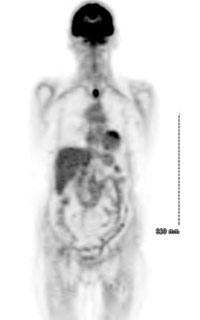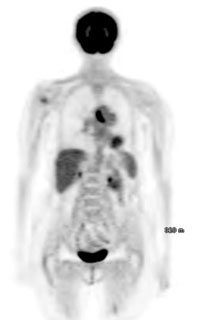A case of malignant endotracheobronchial carcinoma
A 83 year-old woman initially presented with a 50 pack-year smoking history and early-stage squamous cell carcinoma of the left lower lobe, status post-left lower lobectomy (pT2N0Mx) with negative margins seven years prior, followed by no adjuvant treatment. She had been followed by routine surveillance and was in her usual state of health until she presented to her local emergency department complaining of shortness of breath and difficulty breathing two months prior. Her medical comorbidities included asthma, chronic obstructive pulmonary disease, chronic heart failure, and cardiac dysrhythmia requiring a pacemaker. She had an excellent performance status, and otherwise negative review of systems.
A chest X-ray was conducted and yielded no abnormalities; however, the patient was started on oral antibiotics for presumed pneumonia. Her symptoms had not improved after a 10–day course of antibiotics; she subsequently underwent a chest CT. The CT revealed a rounded density in the thoracic portion of the trachea measuring 1 cm. The patient was continued on antibiotics for two additional weeks. Her symptoms continued, and a follow-up chest CT taken one month later demonstrated an endoluminal, tracheal and left bronchial mass. A PET/CT also conducted at that time demonstrated two FDG-avid lesions: one in the proximal trachea and one in the left tracheobronchial angle. Figures 1 and 2 demonstrate both proximal and distal lesions.
The patient subsequently underwent a bronchoscopy revealing a proximal tracheal lesion located in the left lateral wall 6 cm from the vocal cords measuring 2 cm, and an additional lesion in the left tracheobronchial angle with 50% obstruction of the left mainstem bronchus, measuring 2.7 cm. Biopsy confirmed poorly differentiated squamous cell carcinoma. At the time of the diagnosis, the patient’s symptoms included: persistent cough with intermittent wheezing, occasional exertional dyspnea, and otherwise a negative review of symptoms.
After discussion at multidisciplinary conference, the options included surgery, YAG (yttrium-aluminum-garnet) laser treatment, photodynamic therapy (PDT), external beam radiation therapy and brachytherapy. The consensus was that given the extent of disease along the trachea and distal airway and multiple medical comorbidities, the patient would not be an optimal candidate for surgery. The decision was made to offer a definitive treatment course with YAG laser treatment to the proximal lesion in addition to photodynamic therapy, followed by external beam radiation therapy. The patient went on to receive two treatments with PDT with relief of her acute symptoms of airway obstruction, followed by a planned 60 Gy of external beam radiation therapy to encompass both areas of disease along the airway.
Which of the following statements regarding primary tracheal carcinoma is false?
A)The most prevalent histology of primary tracheal carcinoma worldwide is squamous cell carcinoma, with adenoid cystic being the second most common.
B) Cough and dyspnea are the most common presenting symptoms of primary tracheal carcinoma.
C) Tracheal carcinoma may be typically seen best on chest radiograph.
D) Squamous cell carcinoma of the trachea represents an aggressive tumor, with median survival ranging from six to 12 months.
E) All of the above are true statements.
Case Discussion
In the United States today, there are approximately 45 million former smokers. The majority of new lung cancer diagnoses now occur in former smokers. The above case represents what Slaughter and colleagues first described in 1953, the field cancerization effect in oral cancers, followed by Auerbach’s extension of this work demonstrating the role of tobacco to mutagenize the respiratory epithelium extensively, leading to the development of primary malignancy of the airway.
Tobacco smokers’ respiratory epithelium often contains multifocal premalignant lesions that can occur throughout the tracheal bronchial tree. Wistuba et al reported that the bronchial epithelium in current and former smokers demonstrated multiple foci of genetic changes, particularly in patients with lung cancers.
The realization of a genetically altered field as a cancer risk factor provides a new paradigm for cancer prevention and treatment. As we make advancements in molecular oncology, it will be important to accurately discern between second primary tumor and second field tumor, as this distinction may hold critical clinical implications. Second field tumors may require a different follow-up schedule, as longer survival may result in third and fourth field tumors.
Although we do not present any molecular evidence that demonstrates the clonal association of our patient’s original lung cancer with her subsequent endotracheobronchial malignancy seven years later, it is likely that the alteration of her epithelium along the airway, secondary to years of smoking, is what resulted in a genetically altered field putting her at greater risk for field cancerization and the eventual development of her second malignancy along the airway.
 Figure 1: PET scan demonstrating proximal tracheal lesion. |
 Figure 2: PET scan demonstrating second lesion, located in the distal trachea extending into the left mainstem bronchus. Source: DK Luqman |
Our management of this patient’s disease would not have changed whether it had been conceptualized as a recurrence or a second primary, though it is fascinating to consider the burden of second cancers resulting from field cancerization. A variety of tumors, including primary and secondary malignant tumors and benign tumors may occur in the tracheobronchial tree. Squamous cell carcinoma of the trachea is an uncommon malignancy infrequently cured by either surgery or irradiation. Failure to control the primary tumor has been the most common cause for death.
Due to greater overall survival rates with resection, surgery remains the initial treatment of choice for primary tracheal carcinoma. Surgery typically involves median sternotomy and cervical collar excision; tumors located more proximally require cervical exenteration with mediastinal tracheostomy. Attaining adequate margins while maintaining a functional airway may be quite challenging, and postoperative radiation is generally indicated, with several retrospective series demonstrating improved five-year survival in patients receiving postoperative radiotherapy vs. surgery alone.
Given our patient’s age, multiple medical comorbidities and extent of disease along the airway, surgery was thought not to be the optimal option, due to likely significant impairment on her quality of life following a definitive surgical procedure. Thus, immediate symptomatic management with photodynamic therapy followed by a definitive course of external beam radiation therapy was the preferred management.
Due to the rarity of primary tracheal carcinoma, we are limited to retrospective case series to help guide our management with definitive radiation therapy alone. Doses ranging from 40 Gy to 70 Gy have been described in the literature. Of note, improved local control rates have been reported in those patients receiving > 50 Gy; however, significant caution has been imparted in giving doses > 60 Gy, as severe complications requiring surgical intervention, have been reported with such doses.
Collaborative studies are warranted to (1) determine the optimal radiation dose for definitive irradiation, (2) define the potential role of radiation after complete and partial surgery, (3) determine the role and optimal treatment scheme for high dose rate brachytherapy (4) describe and record the late effects, (5) establish the potential benefit of chemoradiation. Furthermore, the potential molecular origins of field cancerization and the field of injury following cigarette smoke exposure in lung and airway epithelia are critical to understanding their potential impact on clinical diagnostics and therapeutics for smoking-induced airway disease.
Luqman K. Dad, MD, is a Resident Physician in the Department of Radiation Medicine at Roswell Park Cancer Institute. He would like to acknowledge Dr. Jorge Gomez and the Multidisciplinary Thoracic Team for their continued guidance and support.
For more information:
- Ahn Y. Journal of Thoracic Oncology. 2009;4:635-638.
- Auerbach O. N Engl J Med. 1961;265:253–267.
- Braakhuis BJ. Cancer Res. 2003; 63:1727-1730.
- Chao MW. Int J Radiat Oncol Biol Phys. 1998;41:779-785.
- Fields J. Cancer. 1989;63:2429-2433.
- Halpern EC. Perez and Brady’s: Principles and practice of radiation oncology. 5th ed. Philadelphia: Lippincott Williams & Wilkins: 2007:xii.
- Minna JD. J Natl Cancer Inst. 1997;89:1366–1373.
- Mornex F. Int J Radiat Oncol Biol Phys. 1998;41:299-305.
- Wistuba II. Curr Mol Med. 2007;7:3–14.
